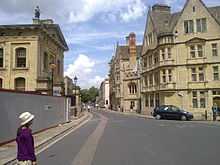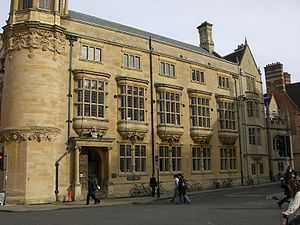Catte Street
Coordinates: 51°45′15″N 1°15′14″W / 51.7543°N 1.2540°W


Catte Street is a historic street in central Oxford, England.[1][2]
Location
Catte Street runs north-south, continuing as Parks Road to the north (beyond a junction with Broad Street and Holywell Street). The street passes along the eastern side of Radcliffe Square and forms a junction with the High Street to the south.[3]
At the northern end to the west is the Clarendon Building on Broad Street, with the Sheldonian Theatre nearby. Just to the south is the Bodleian Library. To the east are the Modern History Faculty (formerly the Indian Institute building), and the Bridge of Sighs over New College Lane which is part of Hertford College.
Further south on the east side is All Souls, a college with Fellows but no undergraduate students. To the west at the southern end are the Radcliffe Camera and the University Church of St Mary the Virgin, the main church of the University, on the High Street.
The southern end of the street, by the junction with the High Street, has been pedestrianised, with a pavement, since 1973.
History
The name of this street was recorded as Kattestreete in the early 13th century, as Mousecatchers' Lane (Vicus Murilegorum) in 1442, and as Cat Street in the 18th century.[1] In the mid-19th century it became Catherine Street. However, there was another street of this name in east Oxford and in 1930 the City Council changed the name to Catte Street, using a 15th-century spelling.
Originally this street road used to lead northwards as far as New College Lane, where the city wall blocked its way. The road north from here has become part of Catte Street, although the Modern History Faculty still gives its address as Broad Street nearby.
In the mid-13th century the illuminator William de Brailes owned property, and presumably had his workshop, next to St Mary's.[4]
The street was pedestrianised as a pavement at the south by the junction with the High Street in 1973.
Cultural associations
Catte Street is mentioned in Philip Pullman's fictional works, His Dark Materials trilogy and Lyra's Oxford.[5]
The street inspired the name of a local 1970s jazz band, the "Catte Street Rhythm Wreckers".
Gallery
-

View north up Catte Street from Hertford College towards Parks Road in the distance.
-

The Indian Institute at the north end of Catte Street to the east.
-

The Bridge of Sighs from Catte Street.
-

The Radcliffe Camera from Catte Street.
-

The ornamental railinged gate of All Souls College on the east side of Catte Street.
-

The south end of Catte Street as seen from the University Church of St Mary the Virgin.
-

Catte Street, looking north past the Radcliffe Camera from its southern, St Mary's, end.
References
- ↑ 1.0 1.1 Catte Street, off High Street, Oxford, Oxford History, UK.
- ↑ Sherwood, Jennifer; Pevsner, Nikolaus (1974). The Buildings of England: Oxfordshire. Penguin Books. pp. 93, 138, 254, 300, 313. ISBN 0-14-071045-0.
- ↑ Hibbert, Christopher, ed. (1988). "Catte Street". The Encyclopaedia of Oxford. Macmillan. p. 72. ISBN 0-333-39917-X.
- ↑ Michael Camille (May 1995). "An Oxford University Textbook Illuminated by William de Brailes". The Burlington Magazine. Retrieved 8 October 2013.
- ↑ Simpson, Paul (2007). "Catte Street". The Rough Guide to Philip Pullman's His Dark Materials. London: Rough Guides. p. 229. ISBN 978-1-84353-920-9.
External links
- Visit by Queen Elizabeth II and the Duke of Edinburgh, 1999